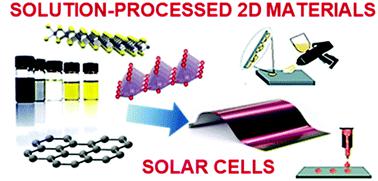当前位置:
X-MOL 学术
›
Chem. Soc. Rev.
›
论文详情
Our official English website, www.x-mol.net, welcomes your feedback! (Note: you will need to create a separate account there.)
Solution-processed two-dimensional materials for next-generation photovoltaics
Chemical Society Reviews ( IF 46.2 ) Pub Date : 2021-09-08 , DOI: 10.1039/d1cs00106j Sebastiano Bellani 1, 2 , Antonino Bartolotta 3 , Antonio Agresti 4 , Giuseppe Calogero 3 , Giulia Grancini 5 , Aldo Di Carlo 4, 6 , Emmanuel Kymakis 7 , Francesco Bonaccorso 1, 2
Chemical Society Reviews ( IF 46.2 ) Pub Date : 2021-09-08 , DOI: 10.1039/d1cs00106j Sebastiano Bellani 1, 2 , Antonino Bartolotta 3 , Antonio Agresti 4 , Giuseppe Calogero 3 , Giulia Grancini 5 , Aldo Di Carlo 4, 6 , Emmanuel Kymakis 7 , Francesco Bonaccorso 1, 2
Affiliation

|
In the ever-increasing energy demand scenario, the development of novel photovoltaic (PV) technologies is considered to be one of the key solutions to fulfil the energy request. In this context, graphene and related two-dimensional (2D) materials (GRMs), including nonlayered 2D materials and 2D perovskites, as well as their hybrid systems, are emerging as promising candidates to drive innovation in PV technologies. The mechanical, thermal, and optoelectronic properties of GRMs can be exploited in different active components of solar cells to design next-generation devices. These components include front (transparent) and back conductive electrodes, charge transporting layers, and interconnecting/recombination layers, as well as photoactive layers. The production and processing of GRMs in the liquid phase, coupled with the ability to “on-demand” tune their optoelectronic properties exploiting wet-chemical functionalization, enable their effective integration in advanced PV devices through scalable, reliable, and inexpensive printing/coating processes. Herein, we review the progresses in the use of solution-processed 2D materials in organic solar cells, dye-sensitized solar cells, perovskite solar cells, quantum dot solar cells, and organic–inorganic hybrid solar cells, as well as in tandem systems. We first provide a brief introduction on the properties of 2D materials and their production methods by solution-processing routes. Then, we discuss the functionality of 2D materials for electrodes, photoactive layer components/additives, charge transporting layers, and interconnecting layers through figures of merit, which allow the performance of solar cells to be determined and compared with the state-of-the-art values. We finally outline the roadmap for the further exploitation of solution-processed 2D materials to boost the performance of PV devices.
中文翻译:

用于下一代光伏发电的溶液加工二维材料
在能源需求不断增长的情况下,开发新型光伏(PV)技术被认为是满足能源需求的关键解决方案之一。在此背景下,石墨烯和相关二维(2D)材料(GRM),包括非层状2D材料和2D钙钛矿及其混合系统,正在成为推动光伏技术创新的有希望的候选者。GRM 的机械、热和光电特性可用于太阳能电池的不同有源组件,以设计下一代设备。这些组件包括正面(透明)和背面导电电极、电荷传输层、互连/复合层以及光敏层。GRM 在液相中的生产和加工,加上利用湿化学功能化“按需”调整其光电特性的能力,使其能够通过可扩展、可靠且廉价的印刷/涂层工艺有效集成到先进的光伏器件中。在此,我们回顾了溶液加工的二维材料在有机太阳能电池、染料敏化太阳能电池、钙钛矿太阳能电池、量子点太阳能电池、有机-无机混合太阳能电池以及串联系统中的应用进展。我们首先简要介绍二维材料的特性及其通过溶液加工路线的生产方法。然后,我们通过品质因数讨论电极、光敏层组件/添加剂、电荷传输层和互连层的二维材料的功能,这使得太阳能电池的性能得以确定并与现有技术进行比较。艺术价值观。我们最终概述了进一步利用溶液加工的二维材料以提高光伏器件性能的路线图。
更新日期:2021-09-08
中文翻译:

用于下一代光伏发电的溶液加工二维材料
在能源需求不断增长的情况下,开发新型光伏(PV)技术被认为是满足能源需求的关键解决方案之一。在此背景下,石墨烯和相关二维(2D)材料(GRM),包括非层状2D材料和2D钙钛矿及其混合系统,正在成为推动光伏技术创新的有希望的候选者。GRM 的机械、热和光电特性可用于太阳能电池的不同有源组件,以设计下一代设备。这些组件包括正面(透明)和背面导电电极、电荷传输层、互连/复合层以及光敏层。GRM 在液相中的生产和加工,加上利用湿化学功能化“按需”调整其光电特性的能力,使其能够通过可扩展、可靠且廉价的印刷/涂层工艺有效集成到先进的光伏器件中。在此,我们回顾了溶液加工的二维材料在有机太阳能电池、染料敏化太阳能电池、钙钛矿太阳能电池、量子点太阳能电池、有机-无机混合太阳能电池以及串联系统中的应用进展。我们首先简要介绍二维材料的特性及其通过溶液加工路线的生产方法。然后,我们通过品质因数讨论电极、光敏层组件/添加剂、电荷传输层和互连层的二维材料的功能,这使得太阳能电池的性能得以确定并与现有技术进行比较。艺术价值观。我们最终概述了进一步利用溶液加工的二维材料以提高光伏器件性能的路线图。



























 京公网安备 11010802027423号
京公网安备 11010802027423号